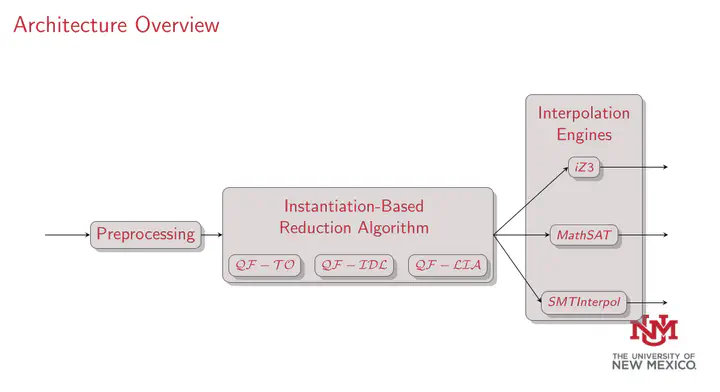AXDInterpolator

This project implements an interpolation algorithm
for the theory of arrays extended with the diff
operator equipped with an index theory $T_I$.
The approach computes a reduction from the $AXDiff(T_I)$
theory to the theory of $EUF + T_I$ and
calls an interpolation engine to process the
reduced formula. Currently, the software supports
iZ3 and Mathsat as such engines.
Building the project
The project requires some z3 dependencies. The
latter can be achieved using the following command from
the root of the project:
git submodule update --init --remote dependencies/z3-interp-plus
If the user wants to use the MATHSAT SMT solver, the
implementation requires a soft link inside the bin
directory. For the latter, use the following command:
ln -s <mathsat-path> ./bin/mathsat
In the root directory, execute the command:
make bin/axd_interpolator
If the above is successful, then binary file axd_interpolator will be located inside the bin directory.
Setting up the input formula
Input formulas are encoded as a SMTLIB2 file
in the ./tests/smt2-files directory. If the input
includes function applications of our extended
language, i.e. diff, length, empty_array, undefined,
then the latter elements should be appended a string
denoting the type of the range of the associated
array element. The latter ensures compatibility with
the internal language used in the implementation.
The following are examples of declarations following
the above convention:
(declare-fun diffInt ((Array Int Int) (Array Int Int)) Int)
(declare-fun lengthArrayIntInt ((Array Int (Array Int Int))) Int)
(declare-fun empty_arrayArrayIntInt () (Array Int (Array Int Int))
The rest of the SMTLIB2 file should specify two assertions. The first one encodes the A-part and the second one the B-part.
Using the implementation
The axd_interpolator binaries receives 4 arguments:
- The first argument specifies the theory to be used. Currently, the implementation supports the quantifier free fragment of the following theories: total order, integer difference logic, unit-two variable per inequality (UTVPI), and linear arithmetic logic. The user should specify
QF_TOto use the total order logic,QF_IDLfor integer difference logic,QF_UTVPIfor UTVPI, andQF_LIAfor the linear arithmetic logic option. - The second argument specifies the path of the smt2 file to work with.
- The third argument specifies the engine/method to be used. For the latter there are three options: 0, 1, and 2.
- Option 0 uses
Z3 - Option 1 uses
MATHSAT - Option 2 uses
SMTINTERPOL
- Option 0 uses
- The fourth argument specifies a number of attempts, i.e. a number that bounds the number of executions of the main loop of the implementation.
The following is an example of an execution of the axd_interpolator binary:
./bin/axd_interpolator QF_TO ./tests/smt2-files/maxdiff_paper_example.smt2 1 100
Note:
If Mac Os is used, the command requires the following to be appended:
DYLD_LIBRARY_PATH=./lib ./bin/axd_interpolator QF_TO ./tests/smt2-files/maxdiff_paper_example.smt2 1 100
The binary axd_interpolator outputs to the standard output any of the following:
- If the formula is unsatisfiable, then it outputs Unsatisfiable: followed by the interpolant obtained.
- If the formula is satisfiable, then the implementation outputs either Satisfiable: or Unknown:. The last option happens when the internal variable
num_attemptsreaches 0.
Replicating SMT 2021 submission results
We included a script to obtain the tables reported in our submission for SMT 2021. For the latter, the following items are neccessary:
- Python3
- Softlink to a mathsat binary file as indicated above.
- Git with LFS support, git-lfs, or download the
files.zipraw file from https://github.com/typesAreSpaces/AXDInterpolator/blob/master/tests/verification-files/files.zip. If the user downloadsfiles.zipdirectly, the zip file should be moved to the tests/verification-files directory.
The steps to execute the benchmarking script are the following:
- Unzip the verification files in tests/verification-files with
unzip files.zip cdinto tests/benchmark/scripts and execute the script./SMT-2021-submission-results.sh- The process will conclude with a Latex-compatible table as output.